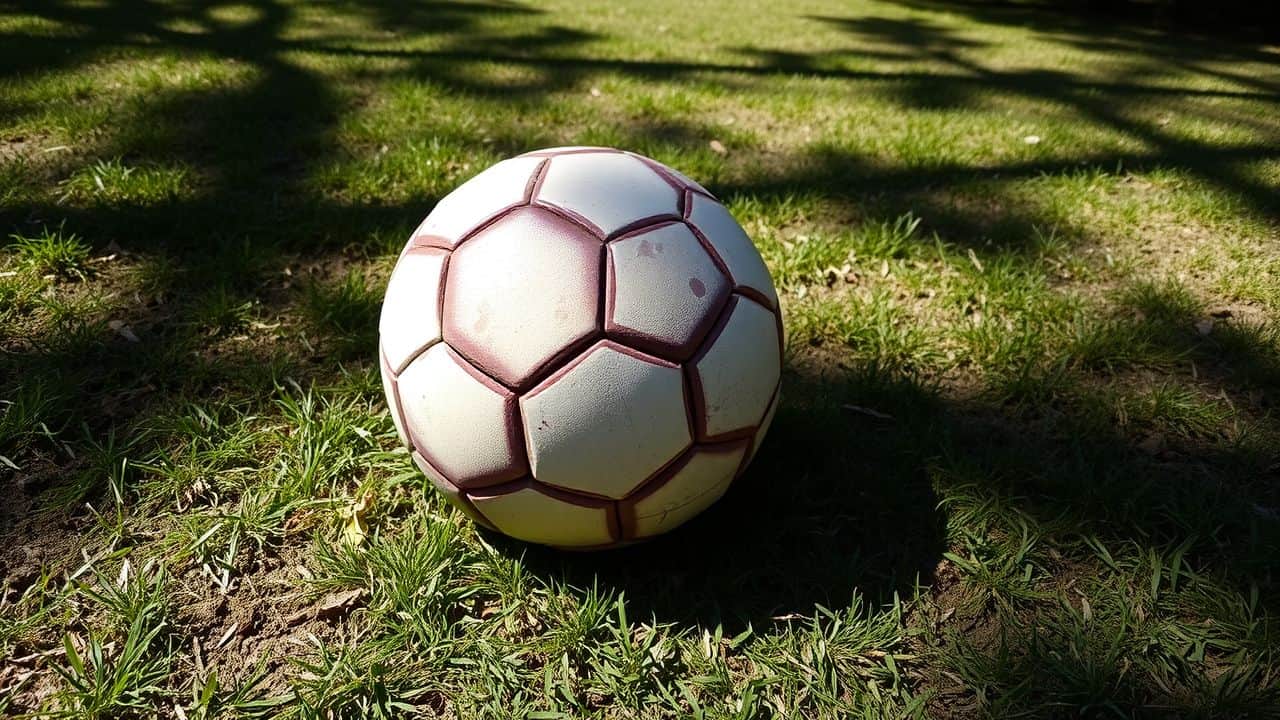Ever feel like you’re stuck in a rut with your soccer skills? It’s frustrating to watch others get better while you stay the same. But don’t sweat it – I’ve done the legwork for you.
After talking to top coaches and players, I’ve uncovered ten pro-level secrets that’ll take your game to new heights. These tips are the real deal, straight from the experts. So, are you ready to kick things up a notch and see some serious progress on the field?
Key Takeaways
Practice daily drills like dribbling, passing, and shooting to improve essential soccer skills.
Build stamina through interval training and long-distance runs, aiming for 30–45 minutes three times a week.
Learn different soccer formations like 4-4-2 and 4-3-3 to understand team tactics better.
Develop a growth mindset by seeing mistakes as chances to learn and improve.
Watch pro matches to pick up new techniques and understand game strategies.
Table of Contents
Mastering Essential Soccer Skills
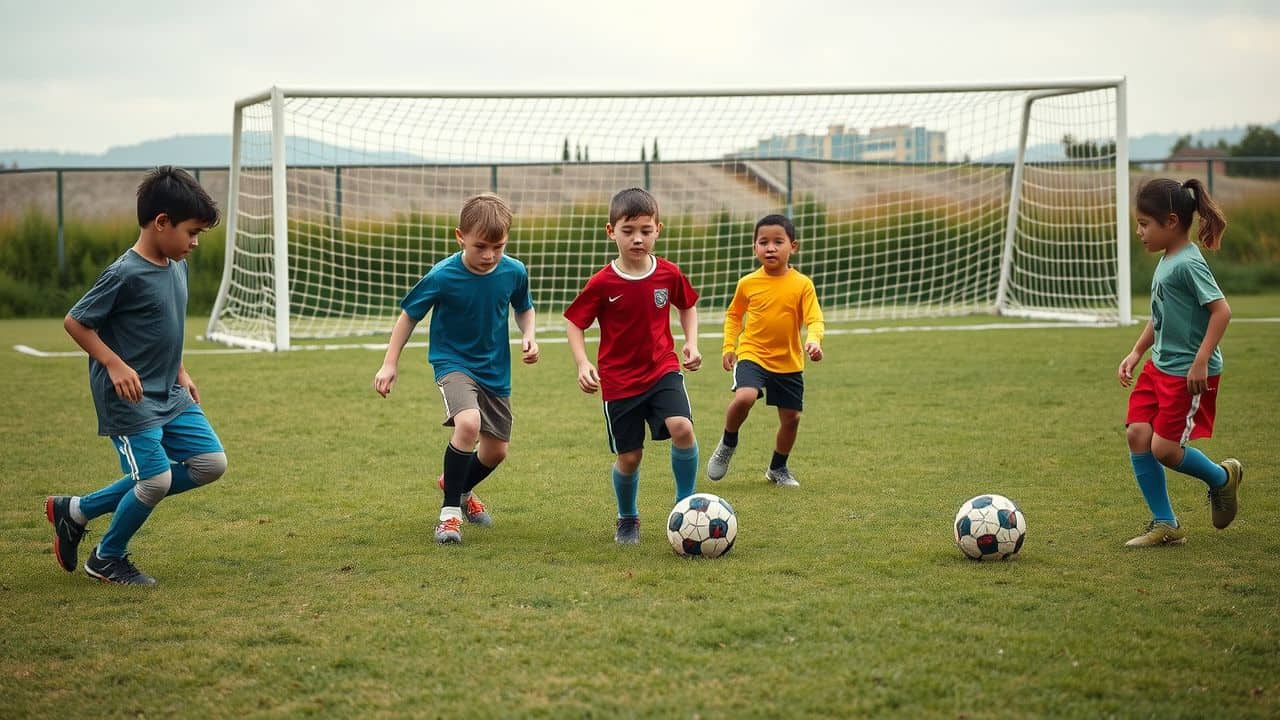
I’ve got the scoop on leveling up your soccer game. Let’s kick things off with the basics – they’re the building blocks of greatness on the field.
Refining Dribbling Techniques
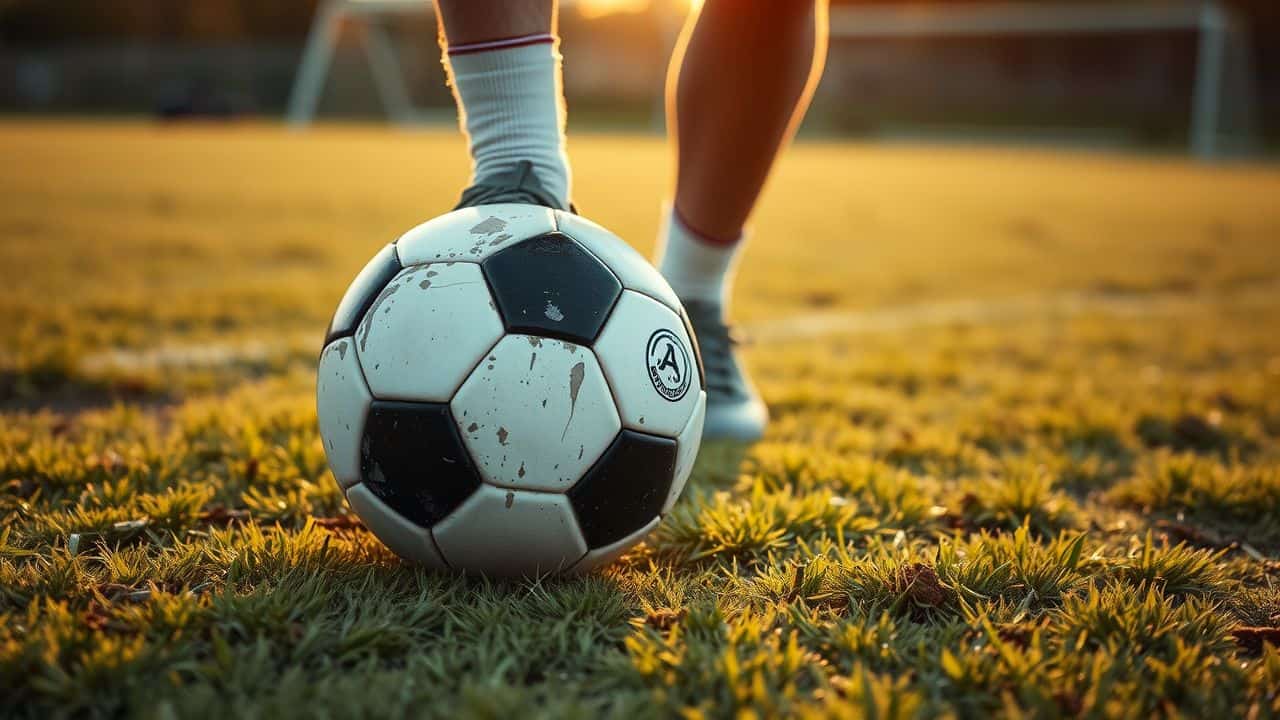
I love dribbling! It’s the heart of soccer. To get better, I practice with both feet daily. I use different parts of my foot – inside, outside, and sole. This helps me control the ball better and create scoring chances.
Nutmegs, stepovers, and rainbow flicks are cool moves to learn. But watch out! Don’t over-dribble or ignore defenders. That’s a rookie mistake – something I learned from my private soccer training near me sessions. These personalized lessons taught me when to use fancy footwork and when to keep it simple.
Dribbling is the art of making the ball dance to your tune.
Enhance Passing Accuracy
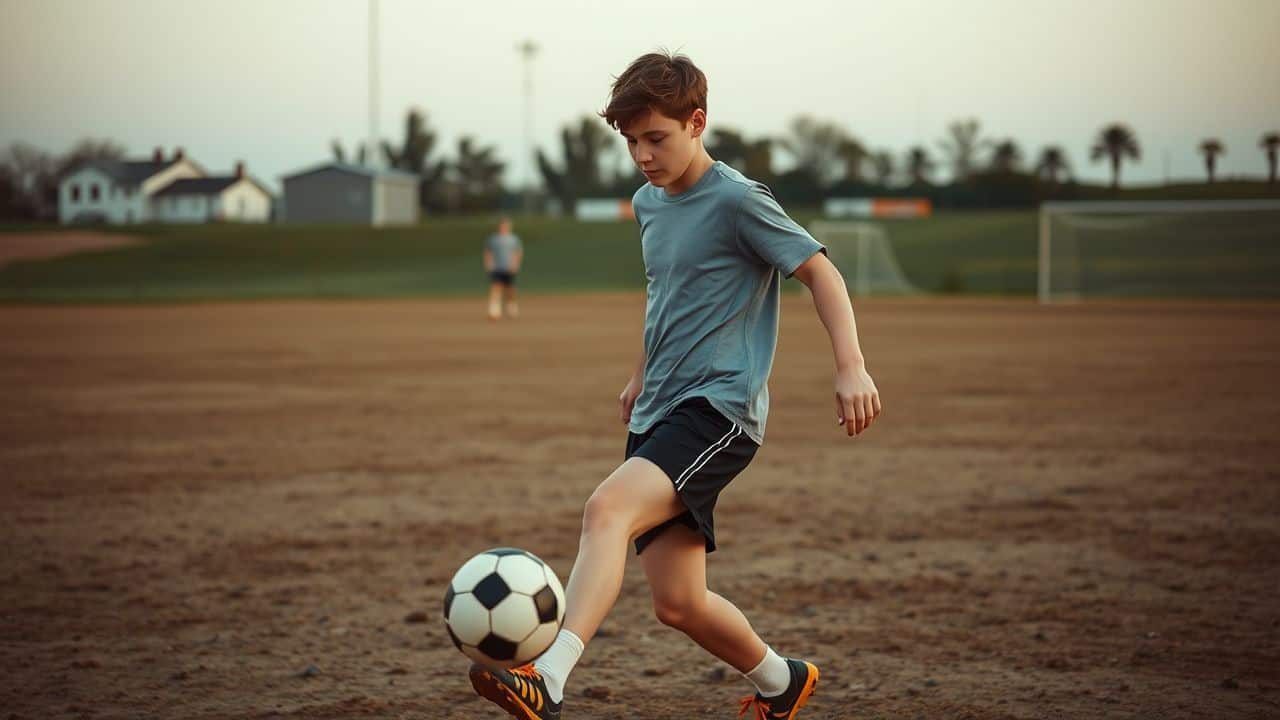
Passing is my bread and butter on the soccer field. I’ve learned that good passing keeps the ball with my team and moves us forward. It’s not just about kicking the ball – it’s about smart play and being fit.
I practice short passes, long passes, and through balls every day. These drills help me get better at reading the game and making quick decisions.
I focus on my non-dominant foot too. It’s tough at first, but it pays off big time. I work on my first touch and ball control to set up better passes. Sometimes, I imagine I’m a pro midfielder, threading passes through tight spaces.
It’s fun and helps me improve. Plus, I’ve found that good passing makes me a better team player. My coach says it’s the glue that holds our play together.
Improve Shooting Effectiveness
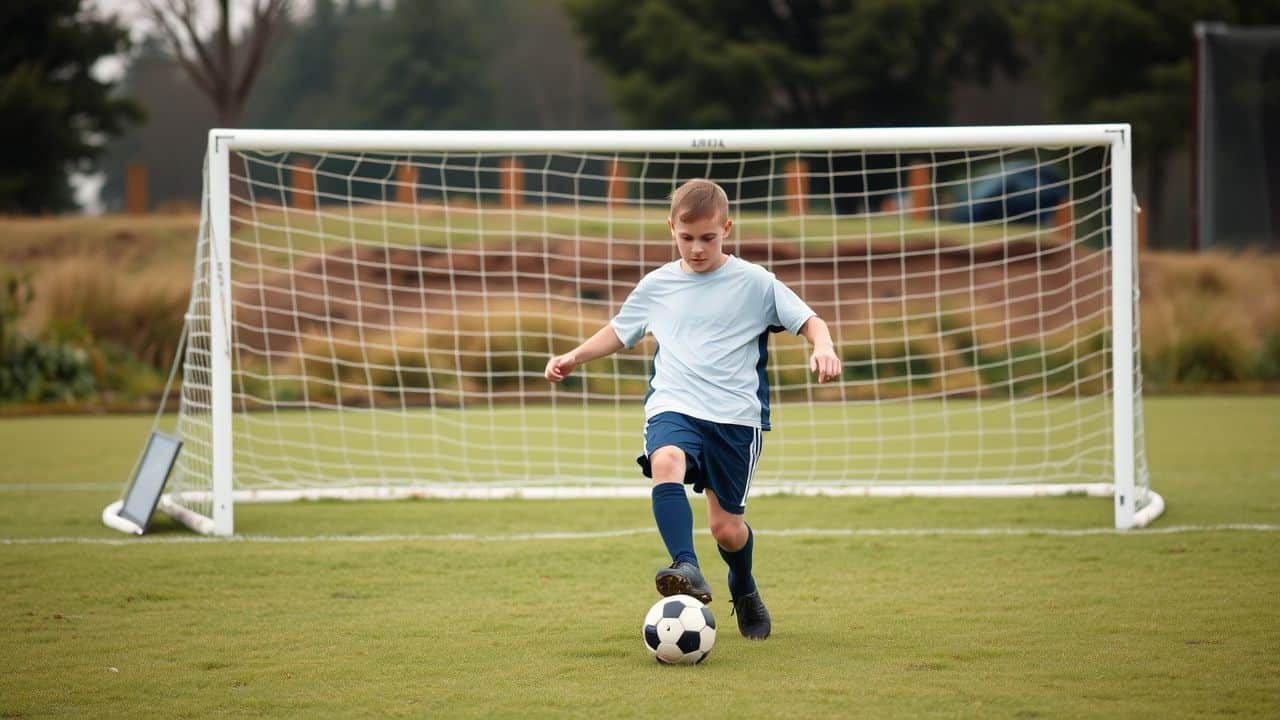
I’ve found that shooting is all about practice and precision. To boost my accuracy, I focus on my body position and where I place the ball. It’s amazing – 69.3% of goals come from zero possession, so quick attacks are key.
I work on my shooting volume, using special drills to improve my technique. It’s not just about kicking hard; it’s about kicking smart.
According to Adam Batansky, a soccer expert at The Sports Economist, science backs up structured training for better shooting. I pay attention to how I’m facing and where the ball is – these small details make a big difference. By tweaking these factors, I’ve seen my shots get more powerful and on-target.
It’s like solving a puzzle, finding the right combo of power, angle, and timing. With each practice, I feel my shots getting sharper and more effective.
Boosting Physical Fitness for Soccer
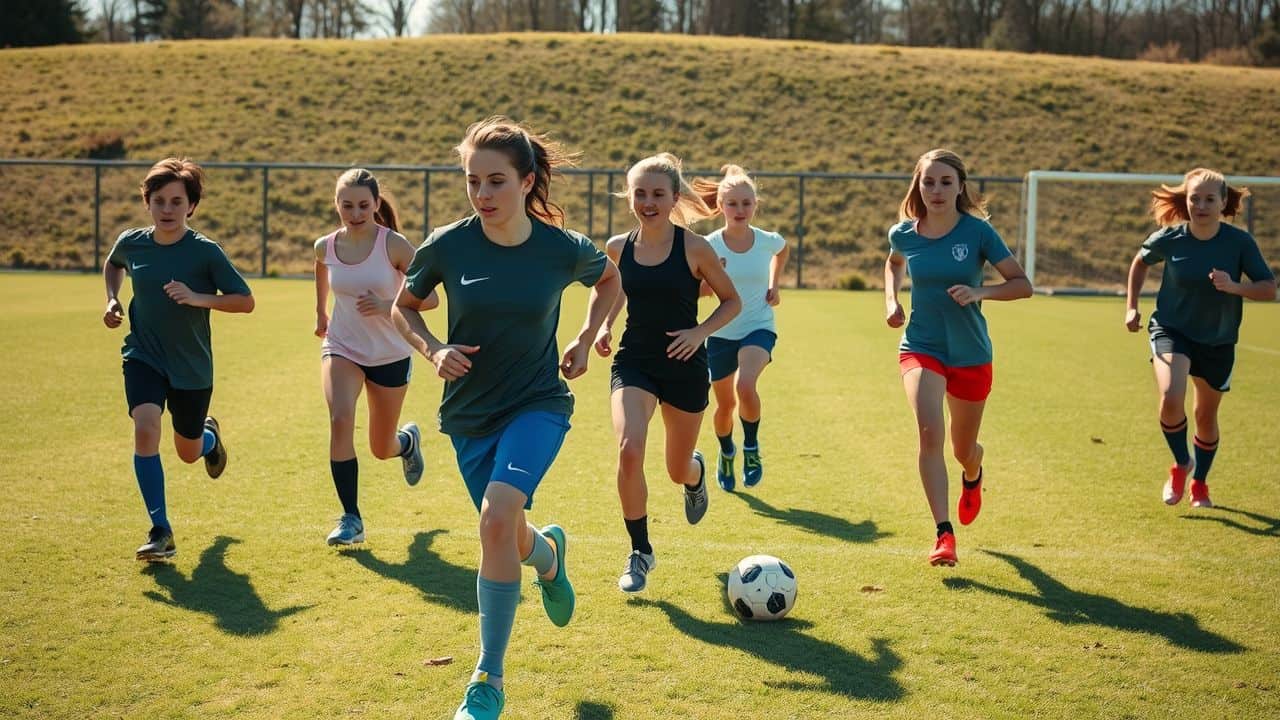
I’ve got a secret for you – soccer isn’t just about fancy footwork. It’s about being fit as a fiddle too! Let’s kick things up a notch and get you in top shape for the field.
Build Stamina and Endurance
I’m all about building stamina and endurance for soccer. It’s key to staying strong throughout the game. My go-to method? Interval training. I mix high and low-intensity activities to push my limits.
Sometimes, I’ll sprint for 30 seconds, then jog for a minute. Other times, I’ll do ball drills to keep my skills sharp while I sweat.
Long-distance runs are also great for boosting endurance. I aim for 30–45 minutes at a steady pace, three times a week. But here’s a pro tip: don’t forget to fuel up! Proper nutrition and hydration are crucial.
I always have a balanced meal before training and keep water handy. It helps me recover faster and keeps my energy up during those tough sessions.
Increase Strength and Flexibility
I’ve learned that strength and flexibility are key to upping my soccer game. Hitting the gym twice a week during pre-season and once during the season has worked wonders for me. I focus on high-intensity resistance training – it’s way more effective than moderate stuff.
My muscles feel stronger, and I can sprint faster on the field.
But it’s not just about pumping iron. I always stretch before practice or games. It keeps me limber and helps prevent those nasty injuries. Trust me, nothing’s worse than sitting on the bench with a pulled muscle! Plus, being flexible lets me reach for those tricky passes and make quick turns without feeling stiff.
Next up, let’s talk about how to develop speed and agility – it’s a game-changer on the soccer field.
Develop Speed and Agility
Now that we’ve built up our strength and flexibility, let’s kick it up a notch. Speed and agility are the secret sauce that’ll make you a soccer superstar. I’m talking about those lightning-fast moves that’ll leave your opponents in the dust.
I love to mix it up with sprint exercises and agility training. These workouts are short but sweet – about 45 minutes, two to four times a week. My go-to drills? Zigzag sprints and the “figure of M” exercise.
They’re tough, but they work wonders for your game. Trust me, once you master these, you’ll be zipping across the field like a pro.
Speed is the difference between a good player and a great player.
Enhancing Tactical Knowledge and Positioning
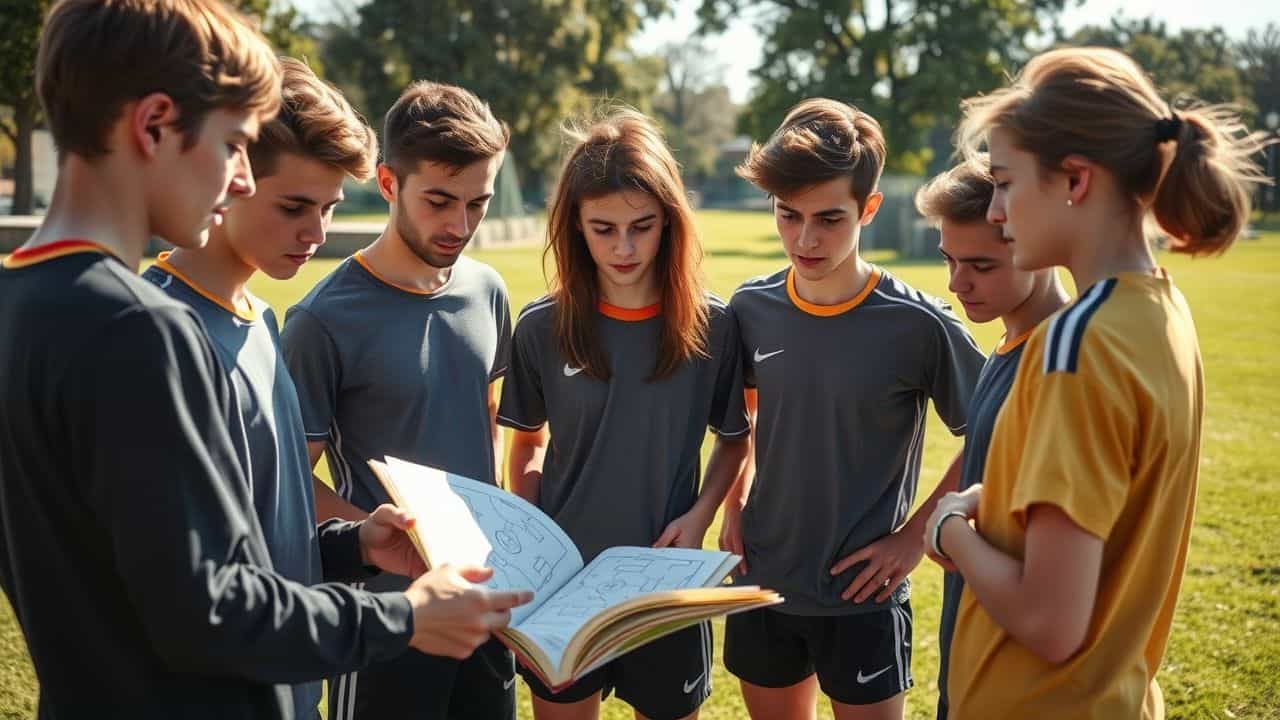
I’ve found that knowing where to be on the field is key. It’s not just about running around. You need to grasp formations and team roles. Want to up your game? Keep reading for more pro tips!
Learn Soccer Formations
I’ve found that learning soccer formations is key to upping my game. It’s not just about where to stand on the field. It’s about how the whole team moves together. I started with the basics – the 4-4-2 setup.
It’s been super popular lately. From 2017 to 2021, many teams used it. But I didn’t stop there. I dug into the 4-2-3-1 formation too. It was big from 2012 to 2017. Teams that got relegated often used this one.
As I learn to play soccer, I’m always trying new things. The 4-3-3 formation caught my eye. It’s a favorite for championship teams.
Stats show it’s linked to more points (p < 0.01). That’s huge! I practice these setups with my team. We switch it up during games. It keeps our rivals guessing. Plus, it’s fun to try different roles on the field.
Practice Role-Specific Strategies
I’ve found that nailing role-specific strategies is key to upping my soccer game. As a midfielder, I focus on quick passes and creating space. For strikers, it’s all about timing runs and finishing.
Defenders need to master positioning and tackling. Goalies? They’ve got to work on reflexes and command of the box. I make sure to practice moves that fit my position on the field.
But here’s the thing – I don’t just stick to one role. I try out different positions in practice. It helps me understand the whole game better. Plus, it makes me more versatile on the field.
I can fill in where the team needs me most. That’s a big plus for any player looking to improve fast.
Enhance Spatial Awareness
Now that we’ve covered role-specific strategies, let’s talk about spatial awareness. This skill is key for any soccer player. It’s about knowing where you are on the field and where others are too.
I’ve found that watching pro games helps a lot. I pick a player and follow their moves. I notice how they find open spaces and use them. It’s like they have eyes in the back of their head! To get better, I practice looking around before I get the ball.
This helps me make quick choices when I do get it. I also play small-sided games to sharpen my awareness. These games force me to think fast and use space well. With time, I’ve seen my game smarts grow.
I make better choices on the field now.
Strengthening Mental and Psychological Skills
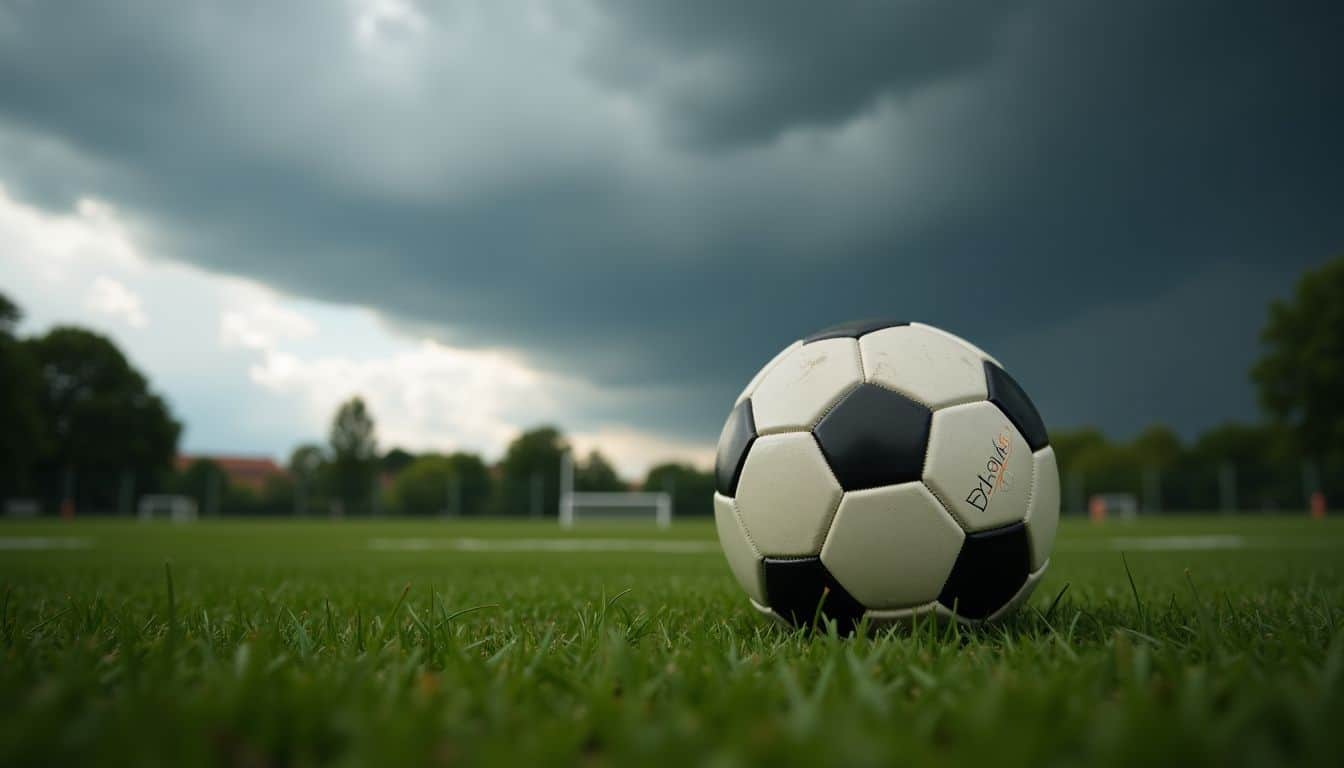
I’ve found that soccer isn’t just about fancy footwork. It’s also about what’s going on in your head. A strong mind can make all the difference on the field – trust me, I’ve been there!
Cultivate a Growth Mindset
I’ve learned that a growth mindset is key to getting better at soccer. It’s all about seeing mistakes as chances to learn and grow. The US Men’s National Soccer Team used this approach under coach Gregg Berhalter, and it worked wonders.
I focus on small improvements in my practice sessions. After each game, I take time to think about what went well and what I can do better next time.
Every setback is a setup for a comeback.
This mindset helps me stay positive when things get tough on the field. Instead of getting down on myself for messing up, I ask, “What can I learn from this?” It’s not always easy, but it’s worth it.
I’ve seen my skills improve faster since I started thinking this way. Plus, it makes soccer more fun when I’m not so hard on myself all the time.
Manage Pressure and Setbacks
I’ve faced my share of tough moments on the soccer field. Pressure can feel like a ton of bricks, but I’ve learned to use it as fuel. When things get rough, I take a deep breath and focus on what I can control.
It’s not about being perfect – it’s about bouncing back. I remind myself that even pros make mistakes. They just don’t let those slip-ups define them.
Setbacks are part of the game, but they don’t have to knock you down for good. I’ve found that talking to teammates helps a lot. We share our struggles and lift each other up. It’s also key to keep things in perspective.
One bad game doesn’t make you a bad player. I use these moments to learn and grow. Mental toughness is like a muscle – the more you work it, the stronger it gets.
Foster Teamwork and Communication
After learning to handle pressure, it’s time to focus on teamwork. I’ve found that great soccer isn’t just about individual skill. It’s about how well we work together.
Talking on the field is key. I make sure to call out to my teammates during games. We use simple words to share info fast. This helps us move as one unit. Off the field, I build bonds too.
I chat with my teammates about more than just soccer. This makes us closer and helps us trust each other more. Studies show that teams who get along well play better together. So, I always try to be a good friend and listener.
It’s not just about winning – it’s about growing as a team and as people.
Designing Effective Practice Routines

I’ve got a secret for you – practice makes perfect! But not just any practice… you need a game plan. Let’s dive into some killer routines that’ll have you kicking like a pro in no time.
Conduct Daily Individual Exercises
I’m all about daily soccer drills. They’re key to getting better, faster.
- Ball handling: I spend 15 minutes each day just dribbling. I weave through cones, practice quick turns, and work on keeping the ball close to my feet.
- Passing practice: I set up targets and aim for them. I mix it up with short passes, long balls, and even try some fancy flicks.
- Shooting drills: I take at least 50 shots a day. I vary the angles, distances, and use both feet to improve my finishing.
- Fitness work: I do a mix of sprints and endurance runs. It helps me stay strong for full 90-minute games.
- Juggling: I try to beat my record each day. It’s fun and great for ball control.
- Weak foot training: I force myself to use my weaker foot for half of my practice time. It’s tough but worth it.
- Wall work: I kick the ball against a wall and control the rebound. It’s great for first touch and reaction time.
- Set-piece practice: I work on free kicks and corners. Accuracy is crucial here.
- Defensive drills: I practice tackling, marking, and positioning. Good defense wins games.
- Mental prep: I spend time visualizing game scenarios. It helps me make quicker decisions on the field.
Organize Team Practice Sessions
I’ve learned a ton about running great team practices. Let me share some tips that’ll help you organize killer sessions for your squad.
- Plan with purpose: I always start by setting clear goals for each practice. What skills do we need to work on? Are we prepping for a big game? This focus keeps us on track.
- Mix it up: Variety is key! I rotate between drills, scrimmages, and fitness work. It keeps the players engaged and tackles different aspects of the game.
- Time it right: I use a stopwatch to keep drills snappy. Short, intense bursts work better than long, drawn-out exercises. It mimics real game situations, too.
- Break it down: I split the team into smaller groups for some drills. It gives each player more touches on the ball and lets me give more personal feedback.
- Make it fun: Soccer’s a game, after all! I throw in some friendly competitions or silly challenges. It boosts team spirit and keeps everyone motivated.
- Get player input: I ask the team what they want to work on. It makes them feel heard and more invested in practice. Plus, they often have great ideas!
- End with a bang: I always finish practice with something exciting. Maybe a full-field scrimmage or a shooting contest. It leaves everyone pumped for next time.
- Debrief and reflect: After practice, I take a few minutes to chat with the team. We talk about what went well and what we need to improve. It helps us grow together.
Now that we’ve covered team practices, let’s look at how you can step up your individual training game.
Implement Scenario-Based Drills
Scenario-based drills are my secret weapon for soccer success. They’ve helped me sharpen my skills and think faster on the field.
- Game-like situations: I set up mini-games that mimic real match scenarios. This helps me react quicker during actual games.
- Decision-making practice: I create drills where I must choose between passing, shooting, or dribbling. It boosts my on-field choices.
- Pressure training: I add defenders to my drills to simulate game pressure. This makes me better at handling tight spots.
- Time constraints: I use a timer in my drills to mimic the urgency of real games. It’s great for improving my speed.
- Position-specific drills: As a midfielder, I focus on drills that hone my passing and vision. It’s key for my role on the team.
- Small-sided games: I love 3v3 or 4v4 matches. They’re fun and boost my engagement while improving my skills.
- Cognitive-motor training: I mix physical tasks with mental challenges. It’s helped my planning and visual search skills big time.
- Varied skill levels: I train with players of different abilities. It pushes me to adapt and grow.
- Tactical awareness: My drills often include formation changes. It’s improved my understanding of team tactics.
- Recovery focus: I add rest periods to my drills. It’s taught me to perform well even when tired.
Gaining Insights from Soccer Professionals
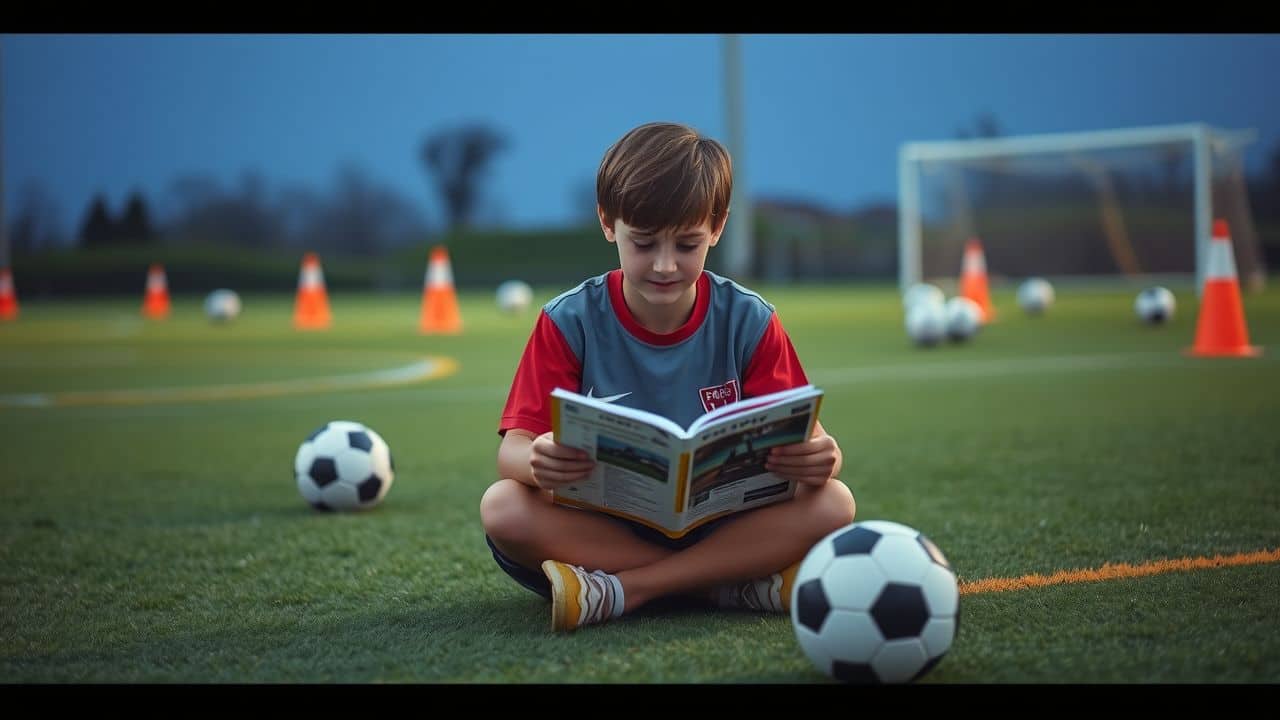
I’ve learned a ton from watching pro matches and going to soccer camps. It’s like getting a peek into their playbook! Want to know more about leveling up your game? Keep reading….
Analyze Professional Soccer Matches
I love watching pro soccer matches. It’s not just fun – it’s a great way to learn! I pick up new tricks by closely watching how the pros move and play. Their positioning on the field is key.
I pay attention to how they create space and make smart decisions. This helps me understand game tactics better.
Watching matches has really boosted my soccer smarts. I’ve learned to spot patterns in how teams attack and defend. Now, I can read the game better when I’m on the field myself. It’s like getting a free lesson from the best players out there! Plus, it’s helped me grasp team formations and player roles more clearly.
Soccer isn’t just about skills – it’s about using your brain too.
Participate in Soccer Clinics and Camps
I’ve found soccer clinics and camps to be game-changers. They’re like a crash course in becoming a better player. At these events, I’ve learned from top-notch coaches and rubbed shoulders with other passionate players.
It’s amazing how much you can pick up in just a few days!
These camps aren’t just about kicking a ball around. They focus on everything from basic skills to advanced tactics. I’ve improved my passing, shooting, and even my mental game. Plus, the personalized feedback is gold.
It’s helped me spot weaknesses I didn’t even know I had. Next up, let’s talk about how to get insights from the pros themselves.
Receive Coaching Feedback
After joining soccer clinics and camps, I found that getting feedback from coaches is key. It’s like having a personal guide who spots my mistakes and helps me fix them. Jenn Ireland, a USSF C-licensed coach, taught me that focusing on errors actually speeds up my progress.
But here’s the trick – I don’t beat myself up over these slip-ups. Instead, I see them as chances to grow.
I’ve learned to ask my coach specific questions about my game. “How can I improve my ball control?” or “What should I do differently when defending?” This way, I get targeted advice that really helps.
Plus, I make sure to listen closely and try out their tips right away. It’s amazing how much faster I improve when I put their feedback into action on the field.
Following Nutritional Guidelines for Soccer Players

I’ve got a secret weapon for soccer success – it’s all about what you eat! Good food fuels your game and helps you recover faster. Let’s dive into some tasty tips that’ll keep you kicking strong on the field.
Prepare Pre-Game Meals and Hydration
I’ve learned that what I eat before a game can make or break my performance. My pre-game meal is like my secret weapon. I aim for a mix of carbs, protein, and veggies – about a third of each.
Grilled chicken with rice and beans is my go-to. Sometimes I’ll switch it up with oatmeal and Greek yogurt. The key? I eat 3 to 4 hours before kick-off. This gives my body time to digest and turn that food into energy.
But food isn’t enough – I’ve got to stay hydrated too. Water is my best friend on game day. I start sipping early and keep at it right until the whistle blows. If I’m feeling peckish closer to game time, I’ll grab a small snack.
Maybe a banana or a handful of nuts. It’s just enough to top off my fuel tank without weighing me down. Next up, let’s talk about how to bounce back after the final whistle.
Focus on Recovery Nutrition
After a tough game, my body needs some TLC. I’ve learned that what I eat right after playing is super important. It helps me bounce back faster and feel better. The pros say I should eat within 30–60 minutes after the final whistle.
That’s when my muscles are ready to soak up all the good stuff.
So, what’s on my post-game menu? I go for a mix of carbs and protein. Sometimes it’s a banana with a handful of almonds. Other times, I’ll have Greek yogurt topped with granola. These snacks give my body what it needs to repair and refuel.
It’s not just about feeling good now – it’s about being ready for my next practice or game. Next up, let’s talk about picking the right gear to up your game.
Consider Supplements for Enhanced Performance
Now that we’ve covered recovery nutrition, let’s talk about supplements. I’ve found some game-changing options that can boost your soccer performance. UEFA backs a few key supplements, and I’m excited to share them with you.
First up, creatine and caffeine. These powerhouses can give you an edge on the field. I love chewing caffeine gum about 100-200 mg before a match. It kicks in fast and keeps me alert.
For endurance, beetroot juice is my go-to. I drink it 2–3 hours before game time. But here’s a pro tip: always test new supplements during practice. You don’t want any surprises during an important match!
Optimizing Soccer Equipment and Gear
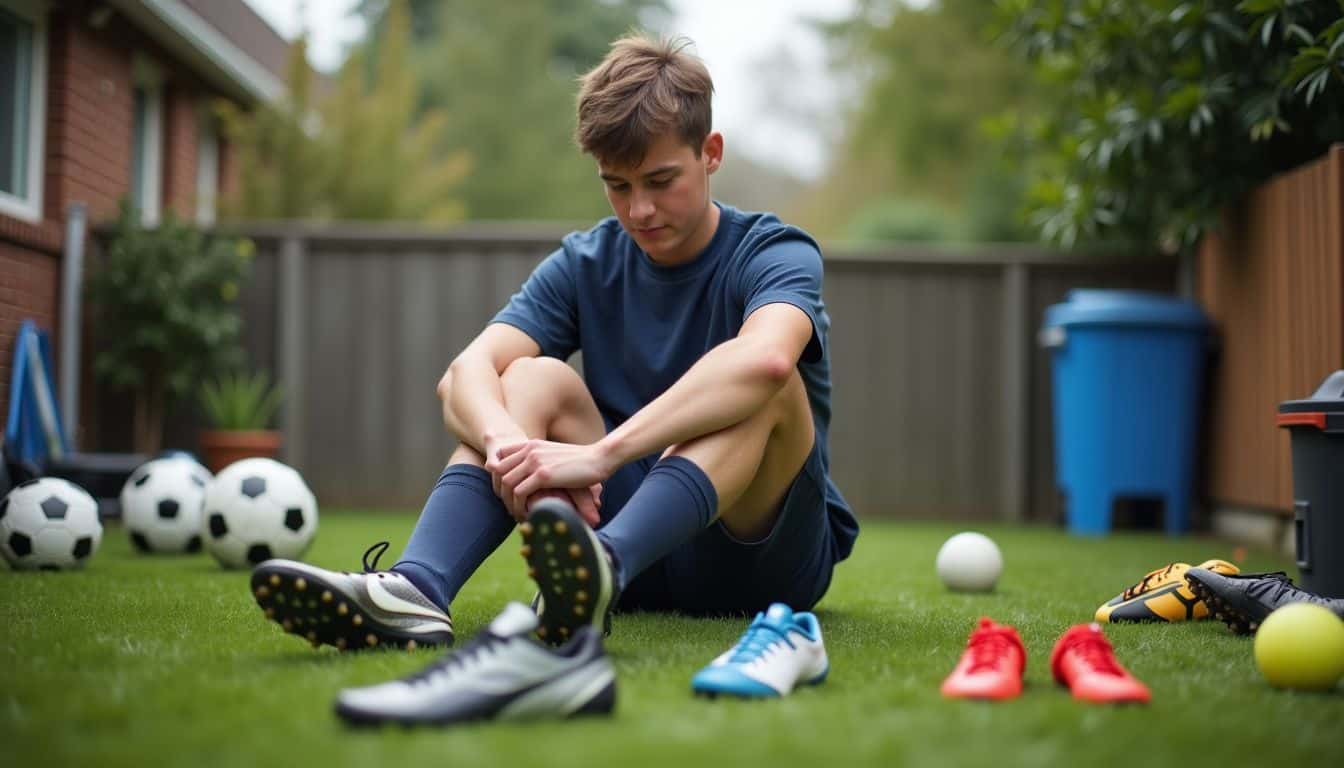
I’ve got a secret weapon for upping your soccer game – it’s all about the gear! Your cleats, ball, and protective stuff can make or break your performance on the field. Let’s dive into how to pick the right equipment that’ll have you playing like a pro in no time.
Select the Best Soccer Cleats
Picking the right soccer cleats is a game-changer. I’ve learned that my cleats need to match how I play and where I play. For firm ground, I go for molded studs. On soft, muddy fields, I pick removable studs for better grip.
Comfort is key – I always try on cleats before buying. Tight spots can lead to blisters, and that’s no fun mid-game. Good traction is a must for quick turns and stops. I look for cleats with solid support to keep my ankles safe during those tricky moves.
My position on the field also affects my cleat choice. As a midfielder, I need a balance of speed and control. Lightweight cleats help me zip around, but I don’t skimp on stability.
I’ve found that leather cleats mold to my feet over time, giving me a better feel for the ball. Synthetic ones are great too – they’re often cheaper and easier to clean. Whatever I choose, I make sure it fits my budget and playing style.
The right cleats can boost my confidence on the field, and that’s priceless.
Choose Quality Soccer Balls
Now that we’ve covered cleats, let’s talk about the heart of the game – the ball. I’ve learned that picking the right soccer ball is crucial. Trust me, it can make or break your practice sessions.
I always go for size 5 balls. They’re perfect for us adult players. Did you know high-quality balls have 32 panels? This design helps the ball fly true. I prefer latex bladders in my balls.
They give a softer feel and better bounce. But if you want a ball that keeps air longer, go for butyl bladders. Oh, and don’t forget to check for certifications like NFHS, FIFA, or the IMS logo.
These marks mean the ball meets top standards. Quality matters – it’s not just about looks!
Prioritize Protective Gear
Now that we’ve talked about quality soccer balls, let’s kick things up a notch. Protective gear is a game-changer, ladies! I can’t stress this enough – it’s not just about looking cool on the field.
Shin guards are a must-have. They’re like your personal bodyguards for your legs. Trust me, when you’re rocking proper shin guards, you’ll feel like a warrior princess out there. You’ll play more aggressively, knowing your shins are safe from those nasty tackles.
But wait, there’s more! If you’re eyeing that goalkeeper position, don’t forget about those gloves. They’re not just for show – they give you super grip powers and keep your hands safe from those rocket shots.
And here’s a little secret: good protective gear actually makes you more comfy during long matches. It’s like wearing a suit of armor, but way more flexible. So, gear up, girls! Your body will thank you, and your game will soar to new heights.
Learning Advanced Soccer Techniques and Skills
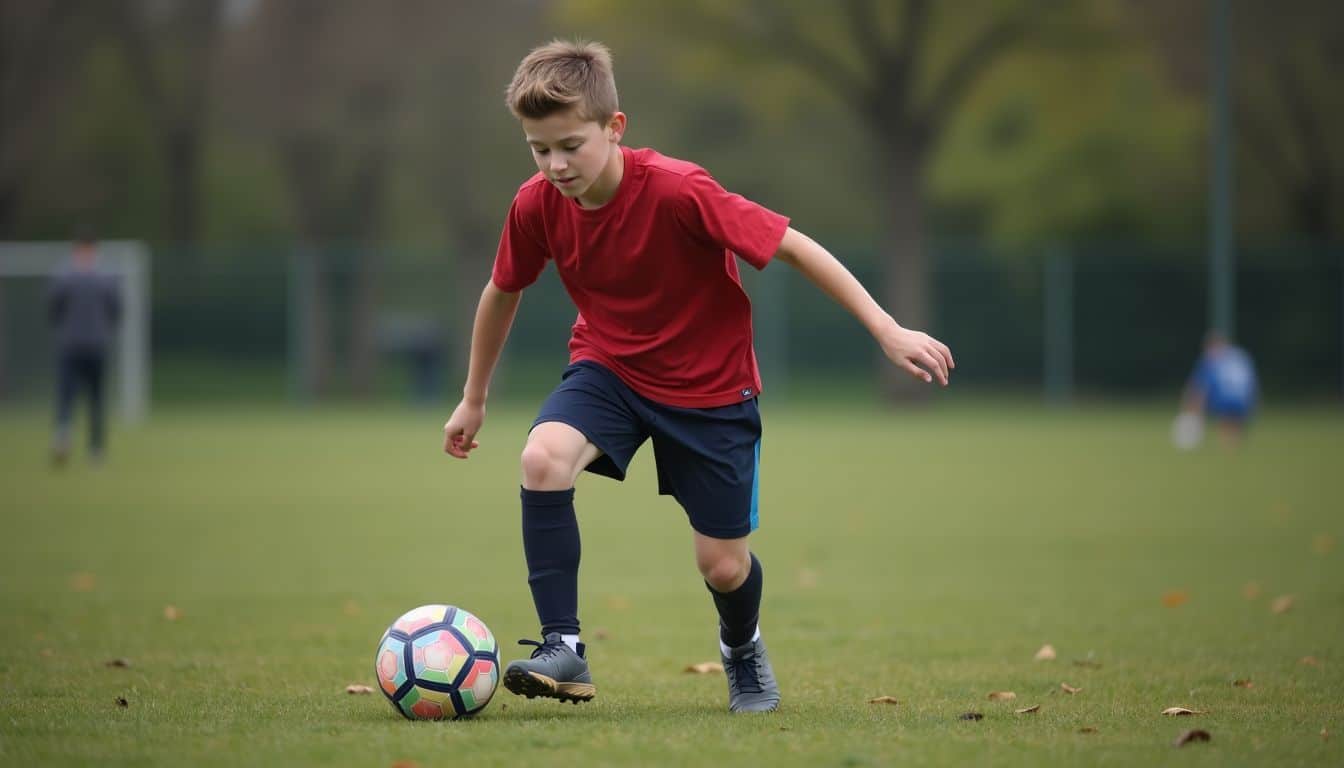
Learning fancy soccer moves can take your game to new heights. Want to dazzle on the field? Keep reading – I’ve got some cool tricks up my sleeve!
Execute Soccer Tricks
I love pulling off cool soccer tricks. It’s like having a secret weapon on the field! I’ve learned some nifty moves like the nutmeg, where I slip the ball between an opponent’s legs.
The stepover is another fun one – I fake going one way, then quickly change direction. These tricks aren’t just for show. They help me keep control of the ball and get past defenders.
Practice makes perfect with soccer tricks. I spend time each day working on my footwork and ball control. The Cruyff Turn is tricky but so useful for changing direction fast. I also practice the rainbow flick to pop the ball over a defender’s head.
It takes lots of tries, but when I nail a new move, it feels amazing. Plus, it gives me an edge during games.
Practice Set-Piece Execution
After mastering soccer tricks, I focus on set-piece plays. These are key moments in the game. Free kicks, corner kicks, and throw-ins can change a match’s outcome. I spend hours honing these skills.
I start with free kicks. I place the ball and pick my target. Then, I practice my approach and strike. For corners, I work on both in-swinging and out-swinging kicks. I aim for specific spots where my teammates can attack the ball.
Throw-ins seem simple, but there’s more to them. I practice long throws and quick, short ones to restart play fast. Set-pieces are a chance to score or create chances. With practice, they become a powerful weapon in my soccer arsenal.
Learn Defensive Maneuvers and Tackling
Now that we’ve covered set-pieces, let’s talk defense. I’ve found that mastering defensive moves and tackling is key to becoming a well-rounded soccer player. As a midfielder, I need to be ready to win the ball back when we lose possession.
Tackling is my go-to move for regaining control. There are three main types: poke, block, and side tackle. I always keep my eyes on the ball to avoid fouls or cards. It’s not easy, but with daily practice, I’ve gotten much better.
I focus on timing and body position to make clean tackles. Defensive skills are crucial for any player, not just defenders. Even as an attacker, knowing how to tackle helps me pressure opponents and create turnovers.
It’s all about reading the game and reacting quickly.
People Also Ask
What’s the secret to becoming a better soccer player?
Practice, practice, practice! But not just any practice. Mix it up with drills that boost your skills as a midfielder or full-back. Work on your non-verbal communication and body language too. It’s not all about fancy footwork!
How important is diet for soccer players?
As crucial as scoring goals! A balanced diet with plenty of veggies and whole grains fuels your game. Skip the junk food and focus on nutrients that’ll keep you running up and down the field all day long.
Can meditation really help my soccer game?
You bet! Mindfulness isn’t just for yoga buffs. It sharpens your focus and calms your nerves before big matches. Plus, it helps you stay cool when the ref makes a bad call about offside or handball.
What’s the deal with strength training for soccer?
It’s a game-changer! Strength training prevents muscle stiffness and builds power for those explosive sprints. Just don’t bulk up too much – you still need to be quick on your feet!
How can I improve my soccer tactics?
Study the pros and pick a youth soccer coach’s brain. Watch games, analyze plays, and learn from the best. It’s like chess on grass – the more you understand the game, the better you’ll play.
Is sleep really that important for soccer performance?
You’re darn tootin’ it is! Sleep is when your body repairs itself. Skimping on shut-eye is like trying to play with one cleat tied – you’re just asking for trouble. Aim for a solid eight hours to stay at the top of your game.
References
https://www.ertheo.com/blog/en/elements-success-in-football/
https://pmc.ncbi.nlm.nih.gov/articles/PMC9394376/
https://dribblersoccer.com/mastering-stamina-in-soccer-training/ (2023-09-23)
https://pmc.ncbi.nlm.nih.gov/articles/PMC5005570/
https://alicantefootballacademy.com/how-to-train-for-speed-agility-football-training/
https://pmc.ncbi.nlm.nih.gov/articles/PMC10407311/
https://www.technefutbol.com/blog/what-is-soccer-vision-and-how-to-improve-it (2023-04-13)
https://www.soccerpsychologytips.com/2019/how-to-have-a-growth-mindset/
https://pmc.ncbi.nlm.nih.gov/articles/PMC9978815/
https://alicantefootballacademy.com/how-to-train-football-individual-exercises-drills/
https://www.veo.co/en-us/article/improve-your-soccer-skills
https://playerdevelopmentproject.com/10-top-tips-for-soccer-session-design/
https://www.ncbi.nlm.nih.gov/pmc/articles/PMC11066207/
https://www.cheltenhamsports.org/content/34326/How-to-get-Better-at-Soccer-10-Essential-Tips (2024-07-31)
https://www.tocafootball.com/journal-post/nutrition-for-soccer-players (2023-08-11)
https://www.soccertoday.com/nutrition-for-soccer-players-the-right-time-to-fuel-up/ (2024-01-31)
https://soccer-formation.com/article/soccer-recovery-nutrition/
https://www.mysportscience.com/post/supplements-for-football
https://ods.od.nih.gov/factsheets/ExerciseAndAthleticPerformance-HealthProfessional/
https://www.academy.com/expert-advice/soccer/how-to-choose-the-right-soccer-cleats
https://www.youtube.com/user/ProgressiveSoccer
https://www.amazon.com/Skills-Strategies-Coaching-Soccer-Hargreaves/dp/0880113286
